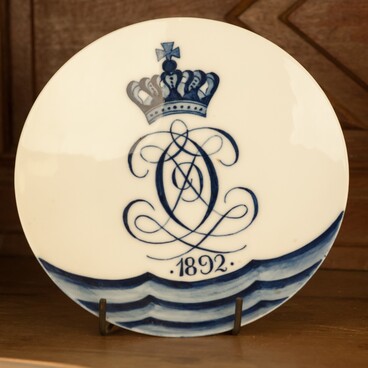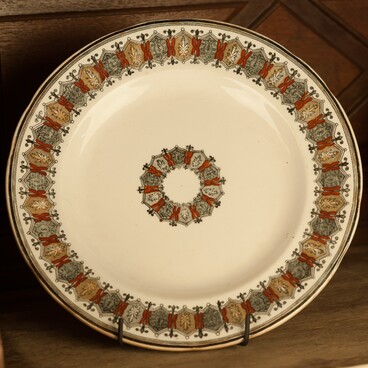This soup plate is part of the dinner service produced by M.S. Kuznetsov Partnership Manufacture of Porcelain and Faience in Dulyovo. Other items from this service are also exhibited in the Alupka museum-preserve. They are made of pure white porcelain, its whiteness emphasized by neat gold-plated ornament.
According to the dining etiquette of the late 19th – early 20 centuries, the dinner set consists of all manners of plates: there are soup plates, appetizer plates, dinner plates, side plates, etc. Like other items from the set, the base of the soup plate is stamped with a state two-headed eagle surrounded by an inscription ‘Kuznetsov Partnership’. Such stamps were only put on high-quality products. The dinner service was held in a private collection until 1995.
Kuznetsov Porcelain Factory production was decorated with a unique style painting: factory painters mastered the technology of making bright ceramic pigments and applying cobalt paint. When decorating more expensive pieces of tableware, gold-plating and engraving were used to make the ornaments more pronounced. At the same time, the actual style was a blend between European painting and traditional Russian one.
At the end of the 19th century, M.S. Kuznetsov Partnership Manufacture of Porcelain and Faience in Dulyovo was one of the biggest porcelain and faience production in the Russian Empire.
In 1887, the porcelain factory in Dulyovo entered the partnership founded by a talented industrialist Matvey Kuznetsov. It was under Matvey Kuznetsov that the factory in Dulyovo reached the peak of its development. His talent for pottery was probably due to the fact that all his ancestors were from Gzhel, a renowned center of traditional blue-and-white ceramics production. The dynasty of porcelain industrialists was founded by his great-grandfather, Yakov Kuznetsov. It was Matvey Kuznetsov who provided all the departments of the factory with modern equipment which he had brought from France. The factory produced both elegant dinner sets for the court and affordable tableware. All the porcelain items were decorated, which greatly contributed to the popularity of the factory. Altogether, Kuznetsov factories employed 1300 full-time workers and 4000 part-time workers. Kuznetsov had his wares in 10 major cities of Russia. Kuznetsov managed to conquer foreign markets and become a decent competitor to European porcelain manufacturers. Items produced by the ‘Kuznetsov Porcelain Empire’ was top-quality and was awarded with Gold medals at the Fairs in Paris and Tashkent. Porcelain and faience tableware were in high demand not only in Russia, but also in Turkey, Persia (modern-day Iran), Bulgaria, Japan, United States, Austria, India, etc. A diverse and unique production range was key to making profit.
The Dulyovo factory became known around the world for its original and exquisitely crafted products, which have remained a gold standard of porcelain making for over 200 years.
According to the dining etiquette of the late 19th – early 20 centuries, the dinner set consists of all manners of plates: there are soup plates, appetizer plates, dinner plates, side plates, etc. Like other items from the set, the base of the soup plate is stamped with a state two-headed eagle surrounded by an inscription ‘Kuznetsov Partnership’. Such stamps were only put on high-quality products. The dinner service was held in a private collection until 1995.
Kuznetsov Porcelain Factory production was decorated with a unique style painting: factory painters mastered the technology of making bright ceramic pigments and applying cobalt paint. When decorating more expensive pieces of tableware, gold-plating and engraving were used to make the ornaments more pronounced. At the same time, the actual style was a blend between European painting and traditional Russian one.
At the end of the 19th century, M.S. Kuznetsov Partnership Manufacture of Porcelain and Faience in Dulyovo was one of the biggest porcelain and faience production in the Russian Empire.
In 1887, the porcelain factory in Dulyovo entered the partnership founded by a talented industrialist Matvey Kuznetsov. It was under Matvey Kuznetsov that the factory in Dulyovo reached the peak of its development. His talent for pottery was probably due to the fact that all his ancestors were from Gzhel, a renowned center of traditional blue-and-white ceramics production. The dynasty of porcelain industrialists was founded by his great-grandfather, Yakov Kuznetsov. It was Matvey Kuznetsov who provided all the departments of the factory with modern equipment which he had brought from France. The factory produced both elegant dinner sets for the court and affordable tableware. All the porcelain items were decorated, which greatly contributed to the popularity of the factory. Altogether, Kuznetsov factories employed 1300 full-time workers and 4000 part-time workers. Kuznetsov had his wares in 10 major cities of Russia. Kuznetsov managed to conquer foreign markets and become a decent competitor to European porcelain manufacturers. Items produced by the ‘Kuznetsov Porcelain Empire’ was top-quality and was awarded with Gold medals at the Fairs in Paris and Tashkent. Porcelain and faience tableware were in high demand not only in Russia, but also in Turkey, Persia (modern-day Iran), Bulgaria, Japan, United States, Austria, India, etc. A diverse and unique production range was key to making profit.
The Dulyovo factory became known around the world for its original and exquisitely crafted products, which have remained a gold standard of porcelain making for over 200 years.



